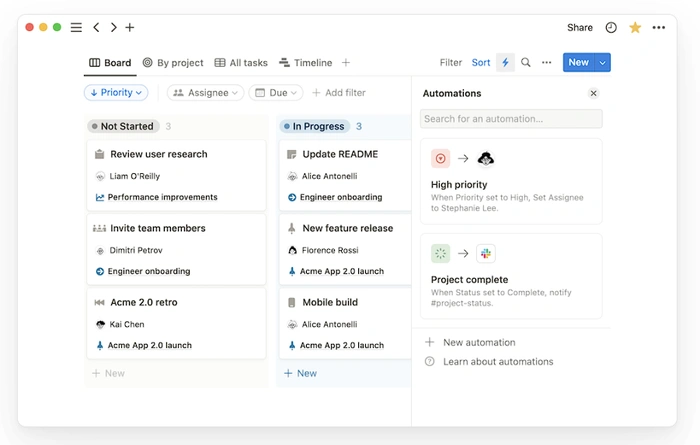Notion has recently introduced a new feature known as database automations. This innovative feature is designed to streamline tasks within the platform, enabling users to automate certain actions based on changes to database pages or properties. This means that users can now set up automatic updates that can change a status, reassign task owners, update entries in a related database, or even send Slack notifications, among other things.
Database automations are essentially sequences of actions that are triggered whenever a specific change to a database occurs. These automations are composed of two main elements: “triggers“, which are the causes of the change, and “actions“, which are the results of the change.
This dynamic duo of triggers and actions can be utilized in a myriad of scenarios. For instance, when a task status changes, it can be automatically assigned to a specific person. Or, when a new page is added, a notification can be sent in Slack. Even when a property is changed, a page property in another database can be edited.
Notion database automations
One of the standout features of Notion’s database automations is the ability to create a timestamp in a completed date property anytime the status of a task changes from in progress to complete. This feature provides users with a clear and precise record of when tasks were completed, enhancing productivity tracking and project management.
Moreover, the automation feature also allows users to create default tasks whenever a new project is created in a project database. This can significantly streamline the project initiation process, ensuring that key tasks are not overlooked.
The database automations feature operates on an “if this, then that” style automation. This means that a trigger, such as creating a new page or editing a property of an existing page, will automatically initiate one or more actions. Users have the flexibility to set up different triggers for each automation, such as when a new page is added to a database or when a property is edited.
Learn how to use the new Notion Automation features
In addition to these capabilities, the feature also allows users to add new pages to a database, edit pages in an existing database, send Slack notifications to a connected workspace, or edit additional properties of the same page that triggered the automation.
Other articles you may find of interest on the subject of automation and improving productivity :
While the feature is primarily designed for users on a paid Notion account, free users are not left out. They can use automations that come with Notion templates, providing them with a taste of the automation capabilities.
However, it’s important to note that Notion’s database automations feature can potentially be dangerous if not used carefully. It has the power to edit the properties of every single row in a database if no filters are set up. Therefore, users must exercise caution and ensure they have the appropriate filters in place to prevent unintended changes.
Looking ahead, Notion is expected to add additional features to these database automations in the coming months. This suggests that users can look forward to even more ways to automate their tasks and streamline their workflows, further enhancing their productivity and efficiency.
What is Notion?
Notion is a productivity software that serves as an all-in-one workspace for note-taking, task management, wikis, and databases. It was launched in 2013 by Ivan Zhao and his team. The online service aims to provide a flexible environment that can be customized to suit various use-cases, from personal journaling and to-do lists to comprehensive project management for teams.
The software offers a range of features like rich text editing, embedding of multimedia and other external web content, and even the ability to create relational databases. One of its standout features is its block-based structure, where each piece of content (text, image, link, etc.) is treated as a “block” that can be easily moved, modified, or linked to other blocks.
Notion’s flexibility allows it to be used in a multitude of ways, making it popular among a diverse set of users including students, project managers, writers, and software developers. It also supports collaboration, allowing multiple users to work on the same page in real-time, and has integrations with other popular tools like Slack, Google Calendar, and more.
Filed Under: Guides, Top News
Latest Aboutworldnews Deals
Disclosure: Some of our articles include affiliate links. If you buy something through one of these links, Aboutworldnews may earn an affiliate commission. Learn about our Disclosure Policy.







